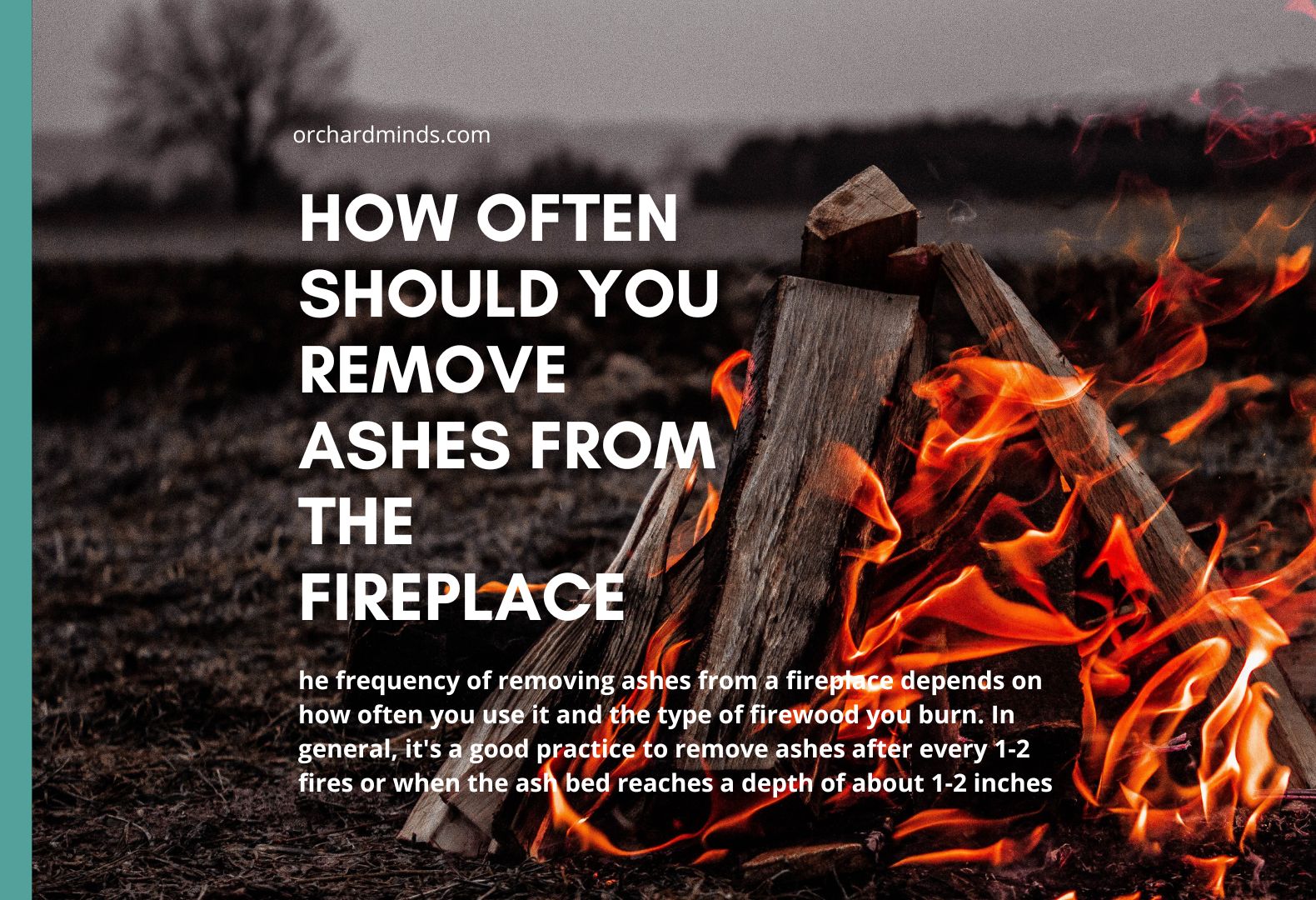When should your fireplace be emptied of ashes? How often to remove ashes from a fireplace largely depends on the frequency of fireplace use and the kind of fuel or firewood that is used. As a rule, it is best to remove ashes from the compartment following the 1st to 2nd fire or the 1to 2 inch ash bed which has formed. However, during the heating season, if the fireplace or stove is used regularly, the ash pit is likely to require a more frequent emptying. It’s best to leave a slight ash coverage (around 1/2 inch) over the embers because it acts as a moderator and keeps it hot and steady. Ash removal is critical for providing safety and ensures the effective functioning of the fireplace or the stove.
The 1/2-Inch Rule
The 1/2-inch rule is a guideline for managing the layer of ashes in your fireplace or wood-burning stove. It suggests leaving a small layer of ash, typically around 1/2 inch in thickness, at the bottom of the firebox after you’ve removed the majority of the ashes. This thin layer of ash can serve several practical purposes:
- Insulation: The 1/2-inch layer of ash acts as insulation on the floor of the fireplace. It helps to maintain more consistent temperatures during your fires. Without this insulation, the base of the fire may get too hot, causing damage to the fireplace and leading to poor combustion. The ash layer absorbs and distributes heat more evenly.
- Kindling Base: When starting a new fire, the thin layer of ash provides a dry and stable base for your kindling and initial wood. It makes it easier to ignite a new fire, as it prevents direct contact between the wood and the cold, possibly damp, surface of the fireplace.
- Airflow: While thicker layers of ash can impede airflow and combustion efficiency, a 1/2-inch layer allows air to circulate effectively. This airflow is crucial for the combustion process, as it provides oxygen to the fire, allowing it to burn efficiently and with minimal smoke.
- Ease of Cleaning: A 1/2-inch layer is a manageable amount of ash to clean up after each fire. It ensures that you’re leaving only a few ashes behind while making the cleanup process more straightforward.
Remember that this guideline is a general rule of thumb and can vary depending on personal preferences and the specific circumstances of your fireplace or stove. Some individuals may choose to leave slightly more or less ash, depending on how their heating appliance performs and their ease of maintaining the fireplace.
It’s important to emphasize that while you leave this small layer of ash, you should still regularly remove the majority of the ashes, as excessive accumulation can block airflow and lead to safety and efficiency issues. The 1/2-inch rule strikes a balance between maintaining an efficient, safe, and easy-to-use fireplace or stove while reaping the benefits of a thin layer of ash for insulation and fire ignition.
When to remove ashes
Deciding when to discard ashes from your fireplace or wood stove is about weighing safety and efficiency versus convenience. In general, you should haul out ash after each fire or if you have about 1-2 inches of ash buildup. You should get into the habit of regularly removing ashes, both for safety and efficiency.
For starters, safety. Ashes may have ash or dormant embers – they can ignite a slow-burning fire and ignite an accidental fire if you are not diligent in disposal. In addition, removing ashes routinely lessens the risk of an accidental fire in your hearth and home.
Secondly, ash removal is necessary for the efficiency of your fireplace or wood stove. If you have significant ash, it will impede the proper burning of wood; surface area and airflow is needed for the fire to be efficient. You cannot have excessive ash because it can impede proper combustion and result in a smokier fire that will not burn effectively that night.
Another key factor is what I call the “1/2-inch rule,” whereby you are leaving a slight amount of ash (about a 1/2 inch) at the base of the fireplace. This thin layer provides insulation and holds the temperature and consistent burns from fire to fire. Layering the area only 1/2 inch thick will also provide a great base for kindling; you won’t be using the ashes to burn and will require your kindling to be dry. Lastly, ashes promote airflow to burn new fuels while allowing for easier, and less messy, cleanup.
How to safely remove ashes
To safely remove ashes from a fireplace or wood-burning stove, follow these steps:
- Allow Cooling: Ensure that the ashes are completely cool to the touch. This may take several hours or even a day after the fire has been extinguished.
- Use a Metal Container: Use a metal container with a tight-fitting lid designed for ash disposal. Avoid using plastic or combustible containers.
- Wear Protective Gear: Consider wearing gloves and a dust mask to protect your hands and respiratory system from airborne particles.
- Scoop Ashes Carefully: Use a fireplace shovel or metal scoop to collect the ashes. Be gentle to avoid stirring up dust.
- Dispose Safely: Transfer the ashes to the metal container and secure the lid. Store the container outdoors, away from combustibles and flammable materials.
- Double-Check for Embers: Before leaving the area, ensure no hidden embers or hot ashes are remaining in the fireplace or stove.
What to do with ashes
Ashes from a fireplace or wood-burning stove can be repurposed or disposed of in several ways:
- Composting: Wood ashes, in moderation, can be added to your compost pile as a source of potassium and other minerals. Be cautious not to add too many ashes, as they can raise the pH of the compost.
- Garden Fertilizer: Wood ashes can be used sparingly as a soil conditioner to raise the pH of acidic soils. This is particularly beneficial for certain plants, like lilacs and tomatoes, that thrive in slightly alkaline conditions.
- De-icing: In the winter, ashes can be used to provide traction and melt ice on driveways and walkways. Be cautious not to overuse it, as it may harm plants or concrete surfaces.
- Trash Disposal: If you don’t wish to reuse ashes, seal them in a bag or container and dispose of them with your regular household trash.
- Hazardous Waste Collection: If your area designates ashes as dangerous waste, follow local regulations for disposal.
How to Deal with Wood Ashes
Dealing with wood ashes from your fireplace or wood-burning stove requires careful handling and consideration of their potential uses and disposal methods:
Double-Check for Embers: Before leaving the fireplace or stove area, ensure there are no hidden embers or hot ashes that may reignite when left unattended.
Cooling: Allow the ashes to cool completely. This is essential to prevent accidental fires or burns. Ensure they are no longer warm or hot to the touch before proceeding.
Safety Gear: Wear protective gear like gloves and a dust mask when handling ashes to protect your hands and respiratory system from airborne particles.
Scoop Carefully: Use a fireplace shovel or a metal scoop to collect the ashes carefully. Avoid disturbing the ashes too vigorously, as it can create dust.
Storage: Place the ashes in a metal container with a secure, tight-fitting lid. This container should be designated for ash disposal and should not be used for any other purpose. Keep the container outside to avoid the risk of indoor fires.
Reuse or Dispose: Decide whether you want to reuse the ashes or dispose of them. Wood ashes can be used in moderation for composting, as a garden fertilizer, or for de-icing walkways. Be cautious not to overuse them in your garden, as they can raise soil pH. If you don’t wish to reuse them, seal the container tightly and dispose of the ashes with your regular household trash, or follow local regulations regarding hazardous waste disposal if applicable.




Leave a Comment